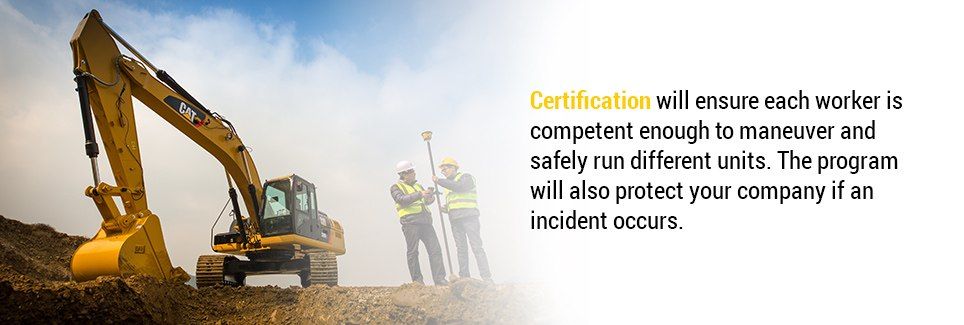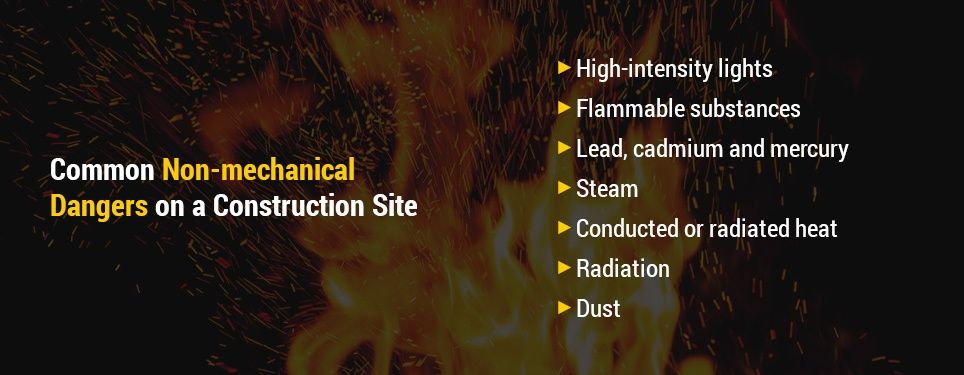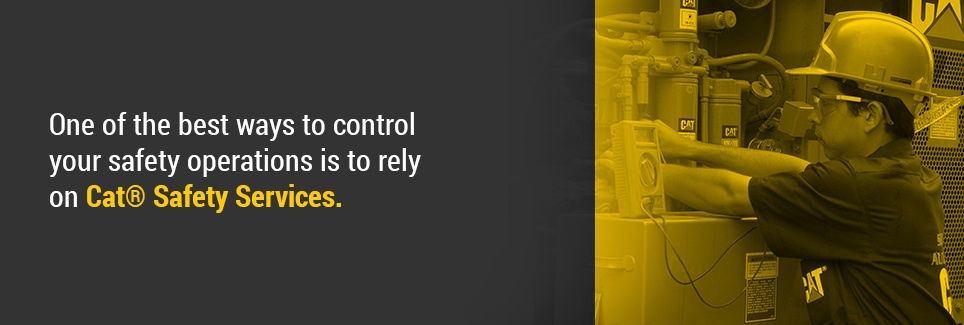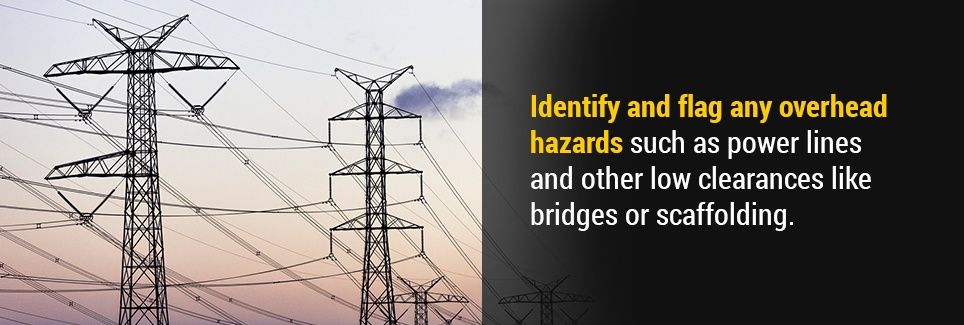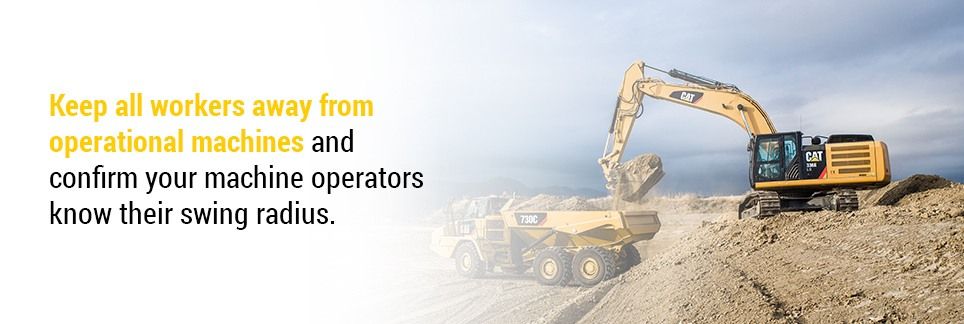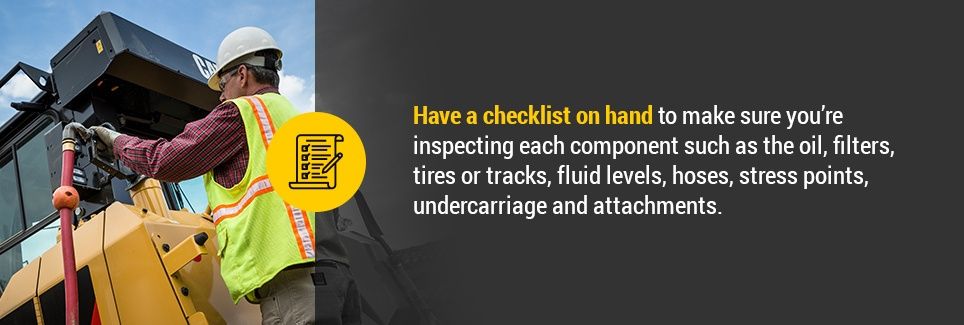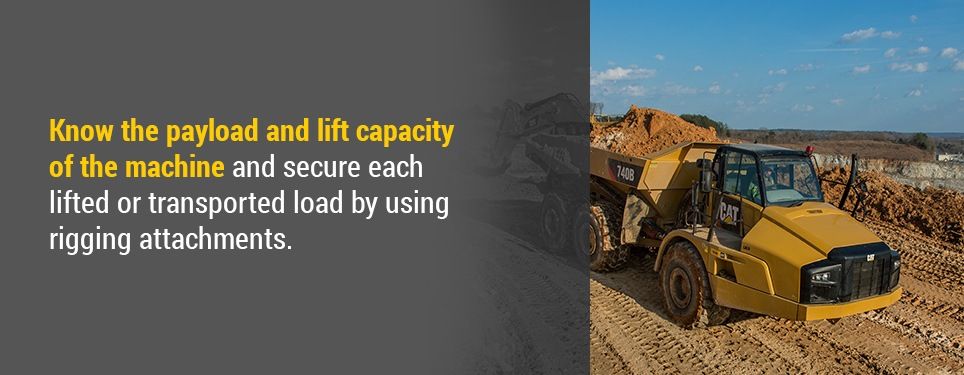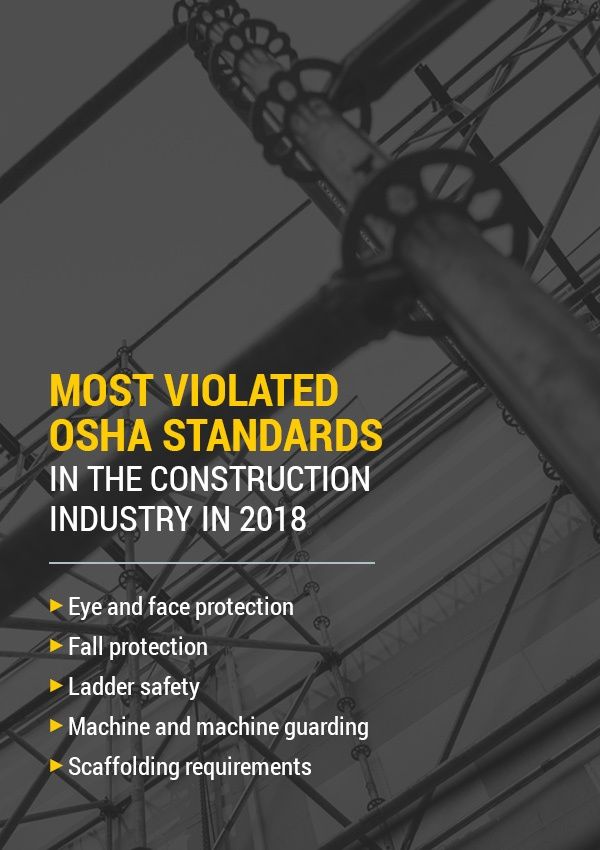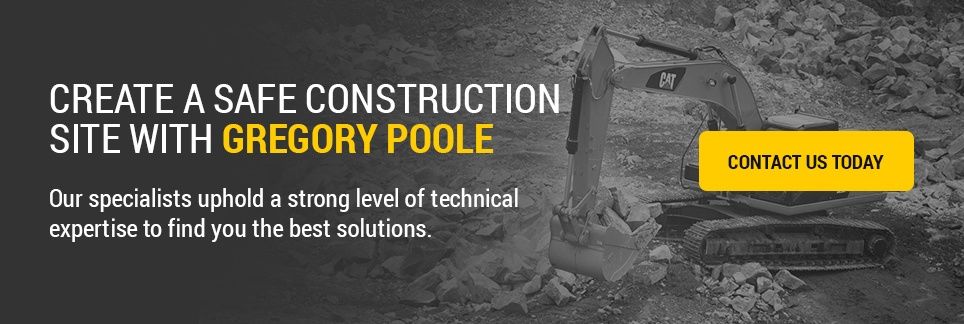Tips for Safely Operating Heavy Equipment
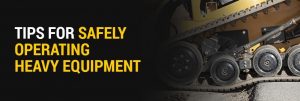
Staying safe on the job site is vital for any line of work dealing with heavy machinery — from demolishing buildings to reconstructing roads. As a fleet owner or heavy equipment manager, you need to know what your equipment is capable of in every situation. If not used properly, machines can become dangerous. However, you can take steps to decrease the potential risks and educate your team on how to stay safe.
Planning Construction Equipment Safety
To maintain a safe worksite and improve the conditions in which your team works, you must adhere to the proper safety measures. The right strategies include staying organized and developing an educational plan for your workers. Your safety program should include workers at all levels of operation, even those who rarely visit worksites. The idea is to eliminate and lessen the number of hazards, whether you oversee 20 sites or two.
Organizing a Safe Work Area
Take a look at your entire operation and determine which areas need the most support. Do your operators understand the rules of the construction site? Does everyone practice safe dismounting? Do your workers understand hand signals?
Here are a few things to consider when making a safety plan:
- Delegate administrative controls.
- Provide in-depth safety instructions and standard operating procedures.
- Encourage verbal communication.
- Eliminate hazards or substitute them for something less risky.
If you can’t get rid of the dangers on-site, your primary focus should be to implement risk controls to prevent or at least reduce the number of injuries.
Communication is also vital to ensure safety regulations are met, and your workers are adhering to the proper protocols. Health and safety regulations on any construction site make it mandatory to relay each workplace hazard.
For example, high-order communication requires you to convey safety cautions. Signs placed throughout a site will educate people about hazardous areas, as well as safe actions they can perform if exposed to inevitable mishaps.
Low-order hazard controls communicate the appropriate precautions by prescribing protective equipment. They also indicate safe workplace behaviors.
Having a Worker Training Program
If your workers aren’t already certified to operate heavy machinery, you can set up a certification program. Certification will ensure each worker is competent enough to maneuver and safely run different units. The program will also protect your company if an incident occurs.
You will also want to educate your team on how to operate each piece of equipment they use on-site. The ongoing training program should include both instructional and hands-on learning to review equipment safety features, identify hazards, maneuver safely and understand safety precautions.
Retraining is imperative, along with follow-up classes. If you notice someone isn’t adhering to the right protocols, you can review one-on-one tactics and mandate additional training.
When structuring an equipment safety plan based on your specific worksite applications and environment, you can establish a more in-depth program to keep your team protected.
Hazards You Can Encounter When Working With Construction Equipment
Situational awareness is a term used to describe a worker’s alertness, as well as an understanding of their surroundings and operations. You and your workers should be aware of the three potential hazards on a construction site: access, mechanical and non-mechanical. When operators, ground workers and project managers are situationally aware, it can decrease the effects of the fatal four from reaching your sites.
Access Dangers
An access hazard is when there is unsafe entry to machinery on a job site. Workers can become trapped or exposed to hazards that are both mechanical and non-mechanical. If you conduct proper planning, put safeguards in place and boost your workers’ awareness, you can help them avoid getting stuck between objects or caught in other severe situations.
The first step is to consider who is allowed into an area at any given time. Think about what pieces of equipment will be in operation and plan an access control plan. When you have a plan, you don’t have to react to unexpected scenarios.
A path site plan indicates where heavy equipment, vehicles and other heavy-duty trucks are allowed to operate through the site. It helps cut backups and keeps machines away from ground workers.
The best way to diminish access hazards is to communicate information regarding each type of danger around heavy machines and where particular people have access.
Mechanical Dangers
In most situations, a machine that is off and parked correctly is safe and stable. It’s when heavy machinery begins to move that workers are more at risk of accidents.
Because construction equipment can harbor enormous amounts of power, capable of destroying buildings and uprooting the Earth, imagine its effects on a human being. While it may not be the best picture to imagine, it’s a concern you must think about as a manager.
Whether you’re operating a piece of heavy machinery or working around the equipment, be aware of the equipment’s moving parts. Mechanical hazards that can affect workers include colliding surfaces, sharp edges, rotating shafts, scissor actions, crushing, cutting, severing and puncturing. Slips and falls can even occur if someone is attempting to dodge a moving part.
The best way to thwart mechanical dangers is to keep everyone on-site situationally aware. Ensure everyone obeys the various protocols and regulations to remain safe.
Non-Mechanical Dangers
Hazards can also result from non-moving components. Your machines have stored energy in the form of pressurized gasses and fluids, along with hot surfaces and electrical charges. A non-mechanical danger can involve harmful substances like chemicals and emissions. Engines also put off loud noises that can damage hearing. Operators and mechanics should assess their machines for non-mechanical hazards before and after each usage.
Common non-mechanical dangers on a construction site include:
- High-intensity lights like welding flashes and lasers
- Flammable substances
- Lead, cadmium and mercury
- Steam
- Conducted or radiated heat
- Radiation like X-rays and microwaves
- Dust
From these various hazards, people can suffer from lung damage, burns, blindness, hearing impairments and even an increased risk of cancer-related illnesses.
Access, mechanical and non-mechanical hazards are preventable when you take the right steps to educate your crews.
Heavy Equipment Construction Safety Tips to Prevent Incidents
One of the best things you can do as a fleet manager is to introduce a corporate culture that puts worker safety first. When you skimp on the necessities, you can put your entire crew at risk. Consider creating an environment where your employees commit to the different construction site safety tips instead of simply being compliant.
It’s best to take a proactive approach and encourage your workers to express their concerns or discuss potential unseen hazards. Everyone should work as a team to get rid of dangers or find ways to create a safer atmosphere. This open approach begins with education, communication and transparency.
Being aware of heavy equipment safety tips is an ongoing process — not a single set of rules. While many guidelines hold true for various applications, dangers can change as your site progresses through each stage in the construction process.
Make sure to discuss evolving conditions, whether they pose a significant or minimal amount of risk. Heavy construction equipment safety tips can support your operations, whether you’re constructing a new bridge or building a housing development.
1. Apply the Appropriate Technology
Eliminating unsafe construction equipment practices and site conditions will mitigate injuries, downtime and operating costs. One of the best ways to control your safety operations is to rely on Cat® Safety Services. It’s a cost-effective and proficient way to protect your workers and machines.
Caterpillar® technology introduces ways you can manage distractions or moderate job site risks like Fatigue Risk Assessment and Fatigue Risk Management Systems. Other solutions Cat offers include:
- Smartband
- Driver Safety Systems
- Ground Worker Detection
- Operator Monitoring
- Sleep Profile Reporting
- Zero-Incident Performance Program
Safety services also include consulting programs and events, as well as precaution surveys. Cat® Technology and Services integrates technology, equipment and services all in a single system. It’s a safety tool for fleet managers of all sizes to help you collect a range of information on your operations and machines. With crucial details at the tip of your fingers, you can make smart decisions on how to manage your fleet.
Install Cat Technology to increase operator visibility, view safety processes, track equipment locations, know machine speeds, reduce the risk of injuries and promote a positive culture.
2. Familiarize Workers With Operator Manuals
Make sure everyone reads the operator manual associated with the unit he or she works with. Manufacturers are transparent about safety procedures to help avoid accidents. The handbooks discuss safety tips, proper usage and regular maintenance.
3. Avoid Line-Of-Fire
The line-of-fire is the circumference around a machine that the machine can reach. For example, the boom on an excavator can reach far past the cab, and as the cab swivels, the machine’s line-of-fire increases.
Stay out of this area to avoid being struck or caught between components. It involves awareness from both operators and ground workers.
4. Be Aware of Underground and Overhead Hazards
Identify and flag any overhead hazards such as power lines and other low clearances like bridges or scaffolding. You can call 811 to learn what type of underground utilities are present in your area. The number will connect you to an expert who can tell you if utility companies have buried lines under your sites like water, gas, sewage and electricity. Mark the sections via colored flags and paint.
5. Be Conscious of Blind Spots
Blind spots are one of the top reasons people become injured on the job. Operators must be 100 percent sure no one is around the equipment when moving or operating its attachments. Blind spots can make you miss people and objects that are beside and behind the equipment.
Because high levels of visibility are crucial, you can install better mirrors or a backup camera, if necessary. Even if you have to get out and check your surroundings before moving, so be it. It’s also smart to have a spotter. They can guide you from a safe and visible position.
Articulate your blind spots to people you’re working with, so they are aware of what areas to avoid. Tell them to make eye contact with you before coming near the equipment.
6. Demand Protective Equipment
Personal protective equipment, such as gloves, safety glasses, boots, hard hats, long sleeve shirts and pants, and ear protection, is critical to keep each worker guarded against a variety of hazards. Breathing apparatuses around dust and contaminants can also be necessary.
7. Educate on Situational Awareness
Situational awareness is being mindful of the area in which you work. Be conscious of overhead obstacles, workers, equipment, rough or slippery terrain, underground utilities and other impediments.
Keep all workers away from operational machines and confirm your machine operators know their swing radius. Make sure everyone is alert, keeping their eyes and mind on each task.
8. Encourage Communication
Operators should be in constant communication with workers and other operators around them. You can use a two-way radio to relay messages, rely on other forms of Cat equipment or use hand signals. Correspondence should be reinforced by managers and everyone in the chain of command. Review different methods during meetings and make sure everyone is up-to-date.
9. Ensure Correct Braking and Blocking
Once you turn off the ignition, engage the parking brake and secure the machine with chocks. You can also secure heavy machinery by lowering its attachments to make sure it doesn’t move when you’re off-duty.
10. Know the Entrances and Exits of a Site
Dedicate specified entry and exit points for your equipment. Each work area should have a clear and safe path that’s free of obstacles for different pieces of machinery to move.
11. Make Eye Contact With Operators
Making strong eye contact with an operator can alert him or her that you are near or that you want to approach them. Eye contact makes sure you’re aware of one another and can prevent operators from swinging attachment toward ground workers.
12. Mark Each Danger Zone
Work hard to keep the site’s work zone clear. Blocking off hazardous areas can prevent workers from entering areas with operating equipment. Mark the limited-access zones and communicate the potential hazards to your crews. Use caution tape, fencing or signage.
13. Perform Walk-Around, Regular and Preventative Maintenance
Walk-around inspections should occur before and after each use of a unit. It’s a more consistent method compared to regular and preventative maintenance — although all three are vital according to the manufacturer’s manual.
Have a checklist on hand to make sure you’re inspecting each component such as the oil, filters, tires or tracks, fluid levels, hoses, stress points, undercarriage and attachments. Check the unit for wear, dents, cracks and leaks, as well as the cab gears. Never use a machine that’s damaged because you can run the risk of forming more severe issues and can put yourself at risk. An operator’s findings should be reported to the company’s mechanic or fleet manager.
14. Practice Correct Loading and Unloading Methods
Always be on level ground when loading and unloading machines from trailers to reduce the risk of sliding and rollovers. When moving off bed ramps, ensure you’re moving into a cleared area free of people, machines and other obstacles. Using a spotter will help you make safe maneuvers.
15. Rely on Spotters
Having a second pair of eyes can help you in a multitude of situations. They’re most necessary if you’re operating around fellow workers, backing up or loading onto a trailer. Operator visibility is vital, so when a spotter is able to see the things you can’t, it helps maintain a safe atmosphere.
Communication, whether verbal or physical, is important. A spotter should be trained to conduct proper hand signals to aid operators, workers and even pedestrians within the vicinity. Make sure spotters wear reflective and visible clothing.
16. Remain Cautious When Fueling
Topping up fuel levels on each machine is a part of an operator’s daily routine. Make sure you can refuel within a controlled environment by having a dedicated fueling station. Install spill containment and ignition sources while making sure it’s isolated from other areas that may cause more hazards.
17. Render Machines as Inoperative When Conducting Maintenance
Practice lockout and tagout procedures when maintaining your equipment. Make sure the engine is off and parked to avoid unexpected startups and random releases of stored energy. Lockouts and tagouts involve the machine as well as its attachments, pinch points and raised loads.
De-energize all the energy sources before servicing, including hydraulic pressure, electrical energy and pressurized heat. The stored energy can inflict harm by burning, electrocuting or scorching you or another mechanic.
18. Teach Proper Three-Point Contact Techniques
The term “three-point contact” refers to a proper mounting and dismounting method. Entering and exiting a unit’s cab requires the right technique. Because falling is one of the biggest determinants in construction site injuries, maintaining three points of contact at all times is essential for safe movements. It can be a combination of two hands and one foot or two feet and one hand.
Never jump off a machine and always use the handholds and steps for extra support. Don’t carry items as you try to enter or exit the cab. Trying to get on or off a moving machine is also prohibited. Make sure to shut off the engine, engage the brake and release pressure from hydraulic controls before exiting. Remember to take the keys with you, too.
19. Understand Load Limits
Different machines have varying load limits depending on the brand, size and engine power. Overloading a machine can increases the chances of tip-overs. If you find you can’t haul enough material with your current fleet, you may need larger units.
If you’re lifting material or equipment, ensure outriggers are in place. Know the payload and lift capacity of the machine and secure each lifted or transported load by using rigging attachments. Make sure people are at a safe distance when hauling massive or small-scale loads.
20. Use Equipment as Intended
Each piece of equipment in your fleet, including its attachments, has a specific task. Make sure you’re working with the right machine for each job. For example, use excavators for digging and skid steer loaders for moving heaps of rubble. When you start using equipment past their purpose, you can put yourself and others at risk.
21. Wear Seatbelts
Operators should wear a seatbelt at all times, even for short periods of work. Accidents won’t avoid you just because you’re operating a unit for a short period of time. A belt can keep you safe if a rollover occurs. The worst thing you can do is jump from the cab if you begin to tip because the unit can angle back and crush you.
Seatbelts also keep you secure when operating on rough terrain. It helps you save energy as opposed to working hard to stay in place.
22. Know Your Limits
Knowing your limits is another crucial aspect of worksite safety. If you feel uncomfortable performing particular tasks, don’t do it. Operating heavy machinery can be dangerous, and not all situations are in your favor. For example, don’t drive up a slope or lift particular loads if you’re feeling hesitant. Staying alert will help you recognize suspicious situations and make the safest decisions for you and others on the construction site.
Sometimes accidents are inevitable, but you can do your part to reduce hazards by keeping open communication, making sure your procedures are up-to-date, holding regular meetings and mandating training. Following these heavy equipment operator safety tips can ensure you lead a safe operation.
The Significance of Heavy Equipment Safety
Safely working around heavy equipment is a matter you shouldn’t take lightly. Both you and your team should be aware of the dangers associated with operating machinery and how everyone can avoid injuries. When you understand the safest procedures, you can ensure operators, ground workers and pedestrians are guarded.
The U.S. Bureau of Labor Statistics stated that 5,250 fatal occupational injuries occurred in 2018 — this number is up two percent from 2017 recordings. Cases concerning contact with objects and heavy machinery increased by 13 percent, caused by a 39 percent upsurge in workers trapped in running equipment and a 17 percent escalation in workers getting hit by dropped items.
The private industry sector calculated about 4,780 worker fatalities in 2018. About 1,000 or 21 percent of them occurred on construction sites.
There are four leading causes of death on worksites, also known as the “fatal four.” The fatal four were responsible for about 59 percent of construction worker deaths in 2018. Of the 1,008 construction site fatalities:
- About 33 percent were caused by falls.
- About five percent were a result of the individual being caught in or between machines.
- About eight percent were electrocutions.
- About 11 percent were a result of the individual being struck by an object.
While falls and electrocutions often pertain to a site’s unsatisfactory conditions, being hit by objects or caught in or between equipment is more about how you operate heavy equipment.
Struck-by injuries include being impacted by falling loads, being in an operator’s blind spot, improper dismounting and braking procedures, rollovers and failure to lock controls during maintenance.
OSHA concludes that almost all accidents caused by the fatal four are preventable in the heavy construction sector. If your company can eliminate the fatal four, you can save your workers’ lives.
The most violated OSHA standards in the construction industry during the 2018 fiscal year included:
- Eye and face protection
- Fall protection
- Ladder safety
- Machine and machine guarding
- Scaffolding requirements
OSHA continues to make headway in diminishing the number of fatalities various industries experience. Compared to 38 deaths each day in 1970, it’s now down to 14 according to a 2017 report.
While OSHA does its part in keeping operators and other members of construction teams safe, responsibility also falls onto the managers of a worksite. With the right information, plan and guidance, you can ensure your men and women adhere to the best construction equipment safety tips.
Partner With Gregory Poole to Create a Safe Construction Site
Gregory Poole values your commitment to a safer and more manageable set of operations. Our specialists uphold a strong level of technical expertise to find you the best solutions. With more than 65 years of experience in the industry, Gregory Poole Equipment Company has 13 locations across eastern North Carolina. We strive to make a personal connection with your business while offering after-sale support.
Browse our heavy equipment for sale or learn more about Cat’s Safety Services. You can contact us online, refer to our website chatting service or call us at 800-451-7278 to speak with a representative.


